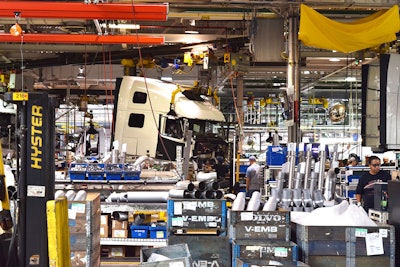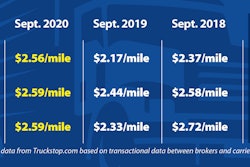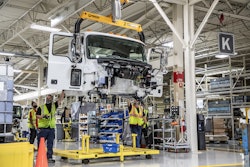 For 2020, FTR projects Class 8 factory shipments to total 194,300 — well below last year’s 349,053. The group forecasts the number to climb to 222,000 next year, 295,000 in 2022 and then to 348,000 in 2023.
For 2020, FTR projects Class 8 factory shipments to total 194,300 — well below last year’s 349,053. The group forecasts the number to climb to 222,000 next year, 295,000 in 2022 and then to 348,000 in 2023.The COVID-19 pandemic and corresponding economic downturn will put a major dent in Class 8 truck and trailer sales this year, though the market has started to recover after orders fell to rock-bottom levels in the worst of the downturn — April and May.
“The market just paused for three to four months,” said Don Ake, vice president of commercial vehicles at forecasting firm FTR, referring to the March-June time frame, when Class 8 orders fell at one point to as low as 4,100 in a month. Orders typically average around 20,000 units a month. “It’s like somebody turned the lights off, and then the lights came back on.” Truck and trailer orders have rallied in recent months, inching upward out of the crater caused by the pandemic and shutdown orders. Trailer orders in August were 28,700, according to FTR data, while Class 8 orders hit 20,500 in August.
Ake spoke alongside FTR CEO Eric Starks and FTR’s Vice President of Trucking, Avery Vise, in an FTR Engage webinar Thursday, part of its ongoing series of virtual sessions being held in lieu of its annual FTR Conference.
Much of the renewed order activity so far has been from larger fleets, said Ake, with smaller and medium-sized fleets holding out due to ongoing uncertainty and risk factors. “We’re not jumping out of this,” said Ake. “We’re climbing out. And we’re still in climb mode.”
For truck and trailer orders, FTR projects a mostly flat market through 2021. Class 8 factory shipments in the first quarter of 2020 totaled 60,378, followed by a steep drop off to just 27,936 in 2020’s second quarter. They project Class 8 shipments in the third quarter, the current quarter, to total 55,300, and another small dip in the fourth quarter, to 50,686.
For 2020, FTR projects Class 8 factory shipments to total 194,300 — well below last year’s 349,053. The group forecasts the number to climb to 222,000 next year, 295,000 in 2022 and then to 348,000 in 2023.
“The industry is in a holding pattern until this uncertainty wanes,” said Ake, referring to the ongoing economic drag, the coming presidential election and the ongoing shockwaves from the COVID-19 pandemic.
Tonnage continued to be choppy in August
On a seasonally adjusted basis in August, truck tonnage dipped by 5.6% from the month prior, according to the American Trucking Associations’ monthly report. That follows a 1.4% dip in July. “The August softness suggests that freight is very uneven in the trucking industry,” said ATA Chief Economist Bob Costello. “The trucking sectors that haul for the industrial and energy industries are not seeing the surge in freight like the consumer side of the economy. The industrial loads tend to be heavier, so they count more in a tonnage calculation than most consumer-related loads. Fleets hauling for retailers are generally seeing strong freight volumes. Carriers hauling heavier industrial products generally saw softer volumes in August.”
Compared with August 2019, the index contracted 8.9%, the fifth straight year-over-year decline. Year-to-date, compared with the same period in 2019, tonnage is down 3.4%.
Driver turnover plummeted in second quarter
Of little surprise, the driver turnover rate in the year’s second quarter — encompassing the bulk of the COVID-19 economic downturn and state and local shutdown orders — fell at both large and small carriers.
“The second quarter was a tumultuous one for trucking, and the broader economy, as restrictions imposed to slow the spread of the COVID-19 had significant impacts on the country,” Costello said. “The coronavirus had a profound impact on the driver market – particularly in the first part of the second quarter. But by the end of the quarter we had begun to see the market tighten again as various restrictions began to be lifted.”
In the second quarter, the turnover rate at truckload carriers with more than $30 million in annual revenue fell 12 percentage points to 82% – the lowest level since the end of 2018. The rate at smaller truckload carriers fell 10 points to 60%, the lowest level since the final quarter of 2011.
“After steep drops early, the driver market began to normalize toward the end of the quarter,” Costello said. “As the economy continues to recover, we should see the market for drivers continue to tighten going forward.”













